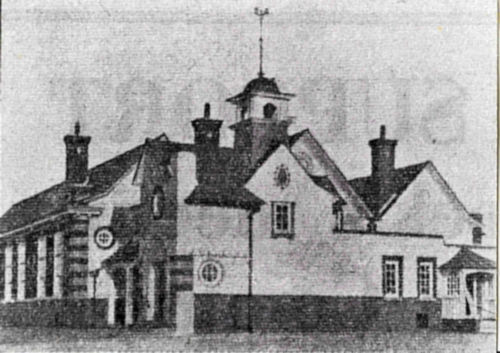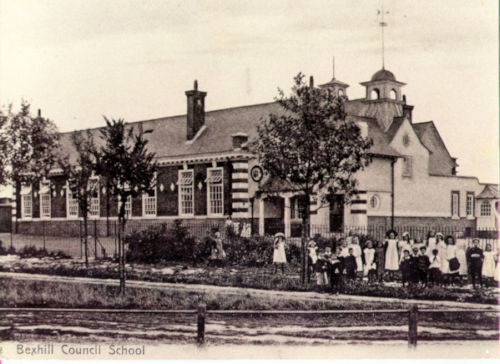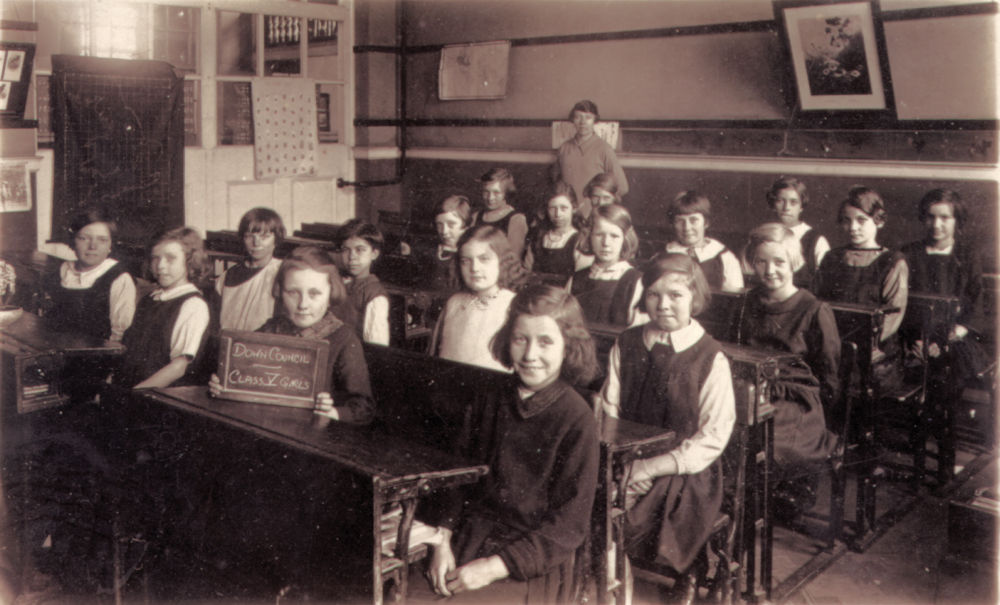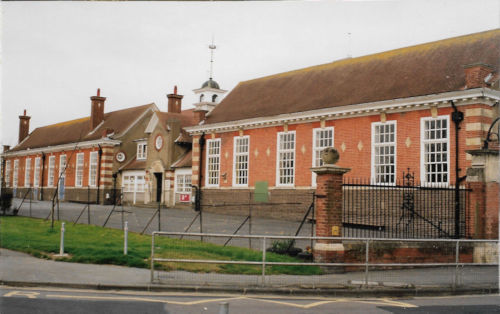The rapid increase in population of Bexhill, from 5,500 in 1891 to just over 12,000 in 1901, created further crises in the educational field. This coincided with the granting of the Corporation Charter in 1902, so that its own Education Committee came into being and, with it, the building of further school accommodation, which was to cater for the influx in the “new” part of the town (southwards and westwards). Out of these crises, the Down School came into being; the first school not under church auspices.
The first part of the Down School was completed in 1907 and catered for 160 infants and girls through to 14 years old; the boys were still housed in Reginald Road.

The school population steadily increased from its opening through the 1930s until the outbreak of the Second World War when a new era began.
As quoted in the log book of the Down School for 1937/8, “….. the school roll is now 335, and approaching the end of the 1930s the school is severely overcrowded”. Remember, there were no extra huts as there are now!
The above photograph shows the first part of the Down School, completed in 1907, as it was before the present Down Infant School was added in 1912. The second part was added southwards from the gabled entrance with the Bell Tower and weathervane loft, as seen comparing the “old” and present photographs.
The exteriors of the Down Junior (now King Offa) and Down Infants have changed little since they were built.
Some entries in the Down School (now King Offa) logbook for the 1930s are given below: –
Each year, entries were made recording participation in Hastings Musical Festival (e.g. teams of girls took part in Country Dance competition) and Town Inter-school sports.

School was closed regularly when children went on Sunday School treats, and when Girl Guide rallies took place on the premises.
Open evenings at the end of autumn terms attracted 300/400 people – including Town Councillors, members of the Town Council Education Committee, parents, and friends. On Empire Days (May 24th) children visited the Playhouse Cinema to see films connected to the Empire, e.g. “Rhodes of Africa” usually at the invitation of the current Mayor of Bexhill.
There were yearly outings, including visits to Westminster Abbey, the Tower of London, St Paul’s, Kensington Museum, the Zoo, Dover, Canterbury, Portsmouth, Southampton, Croydon Airport, Windsor Castle, and Hampton Court.
1934, Nov. 29 School closed for wedding of H. R. H. Duke of Kent.
1935, Nov 6 School closed for wedding of H. R. H. Duke of Gloucester.
1935, May 6, 7, 8 School closed; Silver Jubilee of the reign of their Majesties King George & Queen Mary.
1935, May 7 Children entertained as follows; in the morning they went to the Playhouse to see the film “25 Years a King”; in the afternoon – the country fair in Egerton Park, then tea and conjuring entertainment at the de la Warr Pavilion.
1935, Dec 12 School closed for the opening of the de la Warr Pavilion.
1936, Jan. The timetable has been somewhat suspended to allow for the broadcast of the declaration of the Accession of His Majesty King Edward VIII.
1936, Nov 5 Dinner canteen started – 110 children took advantage.
1937, May 6 Mayor, Mayoress and other Councillors attended the school for the distribution of Coronation Souvenir books and coins.
 1937, May 12-14 Celebrations for the Coronation of King George VI. Friday morning at the Playhouse to see the film “House of Windsor”. Saturday matinee variety performance at the de la Warr Pavilion.
1937, May 12-14 Celebrations for the Coronation of King George VI. Friday morning at the Playhouse to see the film “House of Windsor”. Saturday matinee variety performance at the de la Warr Pavilion.
Late 1930s “….. older children were sent to temporary premises at the Methodist Chapel in Belle Hill due to overcrowding at the school, but this was interrupted when severe weather caused the temperature of the accommodation to fall to 36°F. Children were brought back to the school and the temporary accommodation was closed”.
“There are difficulties of organisation which must persist until the Authority’s building programme provides adequate senior school accommodation. Insufficient space makes a hall class unavoidable, and considerable overcrowding in some classes can only be eliminated by undesirable promotion.”
1939, Sep 18 School re-opened to accommodate evacuees from London with subsequent alterations to school year arrangements.
Morning session:
9 – 12.30 School occupied by Creek Road L C C Boys’ School.
9.30 – 11.30 Our children to various centres (occupational) at Girl Guide Huts, Malet Hall, Christ Church, etc.
Afternoon session from 1 – 4.30 p.m. timetable modified to suit arrangements.
1939, Oct 9 Afternoon session altered from 1.30 – 4.30.
1939, Dec 1 afternoon session altered from 1.15 – 3.30.
Note: The Creek Road children, evacuees from London, were re-evacuated in June 1940. The Downs School was evacuated to Letchworth in July 1940 (304 children) and recommenced in Bexhill in November, 1941.
State School Re-organisation in the 1930s.
The 1930s was a crucial time for education generally, and in Bexhill in particular. By 1930 “the time had arrived when proposals for re-organisation of the whole of the public elementary schools should be taken in hand without further delay” (as the Town Council stated).
Although the 1902 Education Act enabled local authorities to provide secondary education, almost half a century elapsed before such a school was provided in Bexhill.
The Town Council bought land on open space west of the town behind the Down Schools, where the High School now stands. Cuts in Government grants (things don’t change -there was a recession then, too!) led to a five year delay in building. By this time severe overcrowding was being experienced in all schools, elementary education, up to 14, was carried out under one roof and education was stretched to the limits. However a 50% grant became available in 1937.
With the advent of mixed senior schools to cater for 11-14 year olds, the closure of St. Peters Boys School in Holliers Hill and St. Barnabas Girls and Infants in the “new” part of the town south of the railway, in the building which is the present library, was imminent, but in the event, the outbreak of the second world war forced their closures.
Approval for the senior schools was given in 1938, to accommodate 400 girls and 400 boys, and this was made even more urgent by the raising of the school leaving age from 14 to 15 in 1939.
Even with the outbreak of war, building went ahead, but not until 1943 was part of the building ready for scholastic use. The building is virtually the same at the present time, but in 1965 the school was converted to a co-educational establishment as Down Secondary Modern School.

Memories of the Down Council School:
Our headmaster was Mr Hyde, a rather remote figure who emerged for daily assembly. His deputy was Mr Cross. I remember Miss Duffy best – she kept us for two years – at one time 60 of us! Just imagine the howls of protest now. She spent the winter muffled in the coat with the huge fur collar, her nose shrouded in a handkerchief, the latter occasionally stowed away somewhere up her skirt…… Mr Burbridge took us through music, where we roared out items from the National Book…… Mr Jones, the Welsh boyo must have taken the boys for PE and games, and he had a large fan club amongst the girls!
Playtime activities in the girls’ playground:
Skipping (many varieties), Marbles, known as “Alleys”, Chain-tag, Film stars
Cigarette cards (played in pairs) One would roll up a card and stand it on end with another card balanced on the top. The other player would flick her own card from a distance of several feet to try to dislodge the balanced card. If successful, she kept the card(s), if not, she “lost” it.
Ball games, endless varieties. Some were played against the white bricks at the end of the building.
Statues, Swapping stamps and cigarette cards, Hopscotch (2 varieties)
All these activities were wonderful for co-ordination and general knowledge, though we didn’t regard them as such at the time.
One dinner-hour activity, which would have been outlawed had it been discovered, was to crawl through the storm-water pipe which ran underground for about sixty yards under Little Common road and emerged at Pilbeam’s Corner. Only the bravest accomplished this hazardous and daring feat.
Another extremely anti-social activity was standing for as long as possible in the clouds of smoke while gorse was being burned on the Down. Imagine the impact of a group of smoke-saturated children arriving for afternoon lessons!
The highlight of my final year was the school outing to Windsor Castle, and then down-river to Hampton Court. We chartered a steam-train from Bexhill West Station, where Fryer’s Auction rooms are now, and river boat to Hampton Court.
Please note. The above story was supplied to the Museum by Marion Muggridge (nee Hatton), Potmans Lane, Bexhill,

